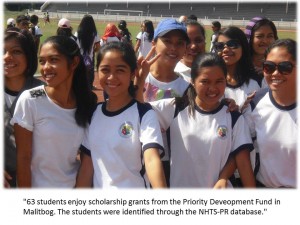 Dubbed as the “Home of Future Millionaires,” the municipality of Malitbog certainly has a lot to boost of. Located 40 kilometers from the regional capital-Cagayan de Oro City, Malitbog is home to a number of residents most of whom are actively engaged in agriculture.
Dubbed as the “Home of Future Millionaires,” the municipality of Malitbog certainly has a lot to boost of. Located 40 kilometers from the regional capital-Cagayan de Oro City, Malitbog is home to a number of residents most of whom are actively engaged in agriculture.
Along with its rich agricultural produce, it also has in its bosom the cleanest river in region 10: the Siloo River. Despite its remote topographical location, the people of Malitbog, particularly the Local Government unit of Malitbog, has always been receptive to change and development. It has opened its doors to new ideas, strategies, and systems of the government. One of which is the utilization of the NHTS-PR data for the implementation of various social protection programs and services in their locality.
The NHTS-PR or the National Household Targeting System for Poverty Reduction is an information management system that the government uses in identifying who and where the poor are and is being spearheaded by the Department of Social Welfare and Development. It aims to address poverty reduction through a scientific and target- focused strategy.
After it has executed a Memorandum of Agreement with the DSWD, the municipality of Malitbog used the NHTS-PR data that has been shared to them particularly in the updating of their Comprehensive Land Use Plan for 2012-2013.
The Municipal Comprehensive Land Use Plan (MCLUP) is an authoritative and legitimate document projecting a better quality of life for the people through its various programs, projects, and activities designed for local governance, socio-economic, and infrastructure. Through the NHTS-PR database utilization, they are assured to have an adequate and accurate land use data.
The NHTS-PR data also ensured that they have the updated data needed for allocation of national and local funds in the local government unit.
The data was also utilized to identify their beneficiaries for the Livelihood Assistance under Community Fund for Agricultural Development (CFAD). This is a component project under the Mindanao Rural Development Program of the Department of Agriculture with the World Bank as the donor entity.
The World Bank has extended a total funding allocation of 7.5 million wherein 10 associations with 448 member beneficiaries were organized, listing of which were based on the NHTS-PR data shared to the Local Government Unit of Malitbog.
These beneficiaries are presently engaged in draft animal dispersal, banana production, post-harvest facility, goat production, cassava production, chicken production and corn production. The municipality was also a recipient of three farm-to-market roads under the Municipal Rural Development Plan.
Another significant use of the NHTS-PR data was in the identification of 50 families for the socialized housing project of the National Housing Authority. This project was designed for the homeless/landless giving priority to families living in hazard prone areas.
The data was also the basis for replacement of senior citizens availing social pension as well those beneficiaries qualified for livelihood assistance such as the Sustainable Livelihood Program (formerly SEA-K) of the Department of Social Welfare and Development (DSWD).
Forty out-of-School Youths, who were identified from the list, have also availed the Cash for Training Program of Technical Education and Skills Development Authority and DSWD as well as the endorsement of four family heads for employment to the Department Of Public Works and Highways. In addition to this, the LGU of Malitbog was also able to recommend 63 students for scholarhship grants under the Priority Development Fund.
As Municipal Social Welfare and Development Officer of Malitbog, Ms. Norma Mabatid considers the data as very useful and informative as far as identifying deserving beneficiaries is concerned.
This is a clear manifestation of how the NHTS-PR data can be very useful and significant in addressing the needs of the locality through its various programs and services. Through the utilization of the data, Local Government Units can assure to the constituents that programs and services are being rendered to those deserving poor households.


